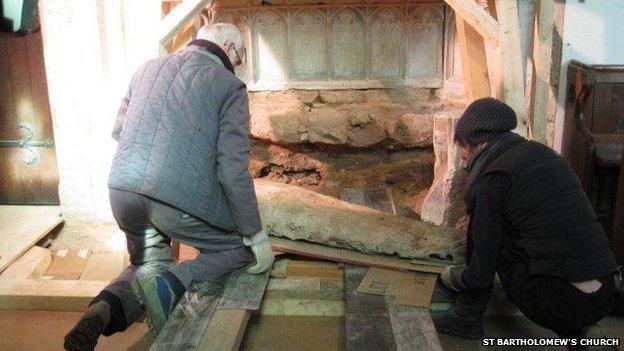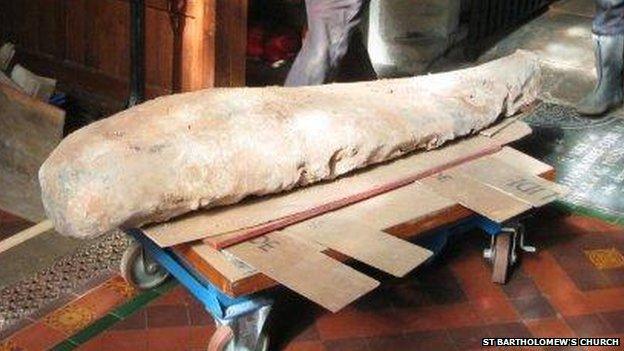Blanch Mortimer: 'Remains' of medieval traitor's daughter found
- Published

Blanch Mortimer, who died in 1347, was the daughter of Sir Roger Mortimer, who overthrew the king and ruled England for three years

English Heritage describes Blanch's effigy as "one of the finest of its date in England" and said the coffin find was "astonishing"
The remains of the daughter of a 14th Century traitor are believed to have been discovered in a church tomb in Herefordshire.
Blanch Mortimer, who died in 1347, was the daughter of Sir Roger Mortimer, who overthrew King Edward II and ruled England for three years.
Work to restore Blanch's tomb at St Bartholomew's Church in Much Marcle uncovered the remains in October.
English Heritage described the find as "astonishing".
'Quite overwhelmed'
The Reverend Howard Mayell, vicar for the parish, said the £500,000 work to restore the church had begun in 2006.
"However, it wasn't until autumn we discovered there was a lead-lined coffin in the tomb, which was a real surprise," he said.
The remains were uncovered in October during restoration work at St Bartholomew's Church
"We kept the discovery under wraps until we had carried out tests and made her secure again.
"There wasn't much left in the coffin, so we can't be absolutely certain it is Blanch but we believe the remains are hers.
"We are quite overwhelmed by the idea Blanch is still in the church."
Blanch's tomb, which is located within the chancel, includes an effigy that has been described by experts as "strikingly beautiful".
Mr Mayell said the monument had been removed for preservation and it was only then the tomb had been discovered.
Michael Eastham, the conservator of sculpture, who was working on the church, said: "We could not work out what it was when we first took the stone panels from the front of the memorial.
"We thought it might be a layer of slate but as we explored further we realised it was a lead coffin."
A spokesman for English Heritage said it was "astonishing" to find a coffin within a tomb, adding: "Usually the tomb chest is empty, with the body buried beneath."
He said: "The coffin is complete, irregular in shape like a lead shroud, and has a number of small holes in it."
The remains underwent an endoscopic examination.
The spokesman added: "The decision was eventually taken that the coffin should not be opened, both on grounds of best archaeological practice and the Church of England policy that human remains should be disturbed as little as possible."
- Published28 January 2014
- Published25 January 2014
- Published3 January 2014
- Published2 February 2013
- Published11 January 2012